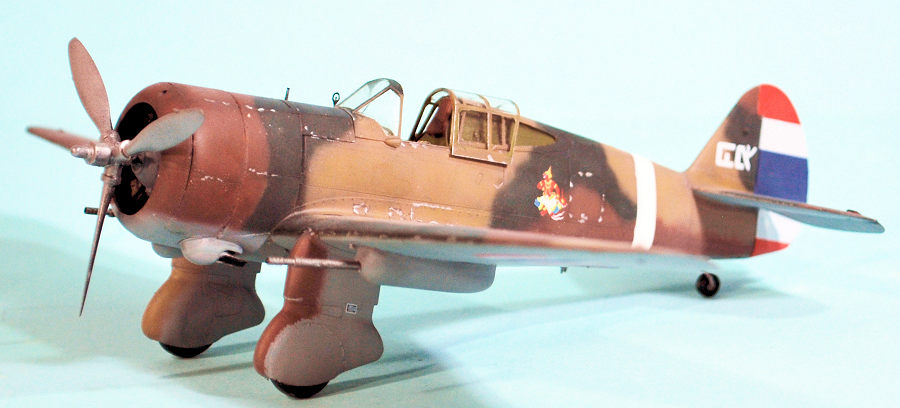
Clear Prop 1/48 Curtiss H75N
| KIT #: | CP4804 |
| PRICE: | $47.00 direct |
| DECALS: | Four options |
| REVIEWER: | Tom Cleaver |
| NOTES: |

| HISTORY |
The Curtiss Model 75 was developed by Donovan A. Berlin, a former Northrop designer, and had more in common with earlier Northrop aircraft than with any previous Curtiss design. It was an all-metal low-wing monoplane, with a fully retractable undercarriage - all three wheels retracted, with the main wheels rotating through ninety degrees on their axis and then folding back into the rear of the wing. The aircraft was powered by a radial engine, starting with an experimental Wright engine.
The Model 75 was designed for an Army Pursuit competition scheduled for May 1935. This version of the aircraft was ready for the May 1935 deadline, but its competitors were not, and so the contest was postponed to August 1935. By August it was clear that more work was needed, and the contest post postponed again, this time to April 1936.
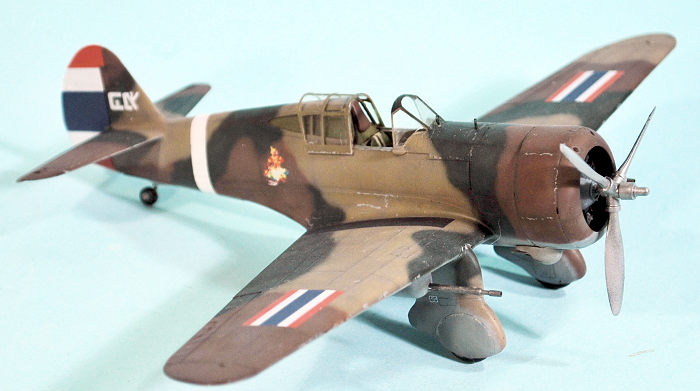 The
Model 75 was competing against designs from Seversky, Chance Vought and
Consolidated. The Seversky design, which eventually won the contest, was a
fighter version of their Amphibian of 1933. Chance Vought produced an improved
version of the Northrop 3A and Consolidated a single-seat version of their
two-seat PB-2A fighter.
The
Model 75 was competing against designs from Seversky, Chance Vought and
Consolidated. The Seversky design, which eventually won the contest, was a
fighter version of their Amphibian of 1933. Chance Vought produced an improved
version of the Northrop 3A and Consolidated a single-seat version of their
two-seat PB-2A fighter.
In April 1936 Curtiss lost out to Seversky, who won a contract to build 77 of their P-35. A few months later Curtiss received a production contract, for three Y1P-36 pre-production aircraft (Curtiss Model H75E), to be powered by the 1,050hp Pratt & Whitney R-1830-13 engine. The first of these aircraft was delivered in March 1937, and they won that year's fighter competition. Curtiss was rewarded with an order for 210 P-36As, the biggest American military aircraft order since the First World War.
Looking for additional sales opportunities, Curtiss began the development of a "simplified" version of the P-36 for export. The "simplified Hawk" project, which was visually different due to the fixed landing grear, was given the company designation of Model 75H. A demonstrator, NR1276, powered by an 875hp Wright Cyclone GR-1820-GE, was publicized in Curtiss sales brochures as a Hawk 75, with emphasis placed on ease of maintenance, rough field performance, and amenability of the aircraft to accommodate different armament. This aircraft was sold to the Chinese government, who presented it to Claire Chennault for personal use.
The Siamese (Thai) government ordered somewhere between 12 and 25 examples, with the designation Hawk 75N Armament was one .30 and one .50 caliber machine guns in the fuselage and two 23mm Danish Madsen cannon housed in detachable underwing fairings.
Twelve 75Ns were delivered to Siam starting in Nov 1938. They were involved in the Thai invasion of Indo-China in Jan 1941, the first recorded combat taking place on January 11, 1941 when four 75Ns escorted nine Martin 139s in an attack on the French airfield at Nakorn Wat. The formation was intercepted by four French Morane-Saulnier M.S.406s. In the resulting air battle, the Thai Hawks claimed two Morane fighters. On H-75N still exists in the Royal Thai Air Museum in Bangkok.
 By
November 1941 the Thai government was certain that war was imminent between
Japan and the United States. Traditionally a buffer state between British Burma
to the west and French Indochina to the east, Thailand followed its
long-standing foreign policy: accommodation to the strongest regional pose, in
this case Japan. Such a policy was not difficult for Prime Minister Field
Marshal Phibun Songkhram, and the Thai Army. Phibun, a ardent fascist, became a
Japanese supporter when Japan mediated the brief war between Thailand and Vichy
France. In return for Japan successfully pressuring France to cede border
territories back to Thailand, Phibun became ardently pro- Japan.
By
November 1941 the Thai government was certain that war was imminent between
Japan and the United States. Traditionally a buffer state between British Burma
to the west and French Indochina to the east, Thailand followed its
long-standing foreign policy: accommodation to the strongest regional pose, in
this case Japan. Such a policy was not difficult for Prime Minister Field
Marshal Phibun Songkhram, and the Thai Army. Phibun, a ardent fascist, became a
Japanese supporter when Japan mediated the brief war between Thailand and Vichy
France. In return for Japan successfully pressuring France to cede border
territories back to Thailand, Phibun became ardently pro- Japan.
At the same time, by training and association, the sympathies of the Royal Thai Air Force (RTAF) were with the Americans, rather than Japan. Throughout the 1930s almost all the RTAF’s combat aircraft were American. Additionally, the best and brightest RTAF officers had trained at the U.S. Army Air Corps Tactical School, where they developed lasting ties with their American counterparts and incorporated American tactics into the RTAF fighting doctrine.
Japan asked for permission to transport troops through Thailand for the planned invasion of Malaya. Phibun was still negotiating this - in the face of popular opposition - at 3 a.m., December 8, 1941, when units of the Imperial Japanese Army began landing along the Kra Isthmus. RTAF pilots from 5th Wing, operating 10 Curtiss Hawk III and nine Curtiss Hawk 75N prepared to opposed this, but a JAAF strafing attack destroyed three of the H-75Ns, Others took off but were quickly overwhelmed. Pilot Officer Maen Prasongdi’s Curtiss Hawk III was shot down by ship’s antiaircraft fire when he attacked troopships in Bankgkok. Flight Sergeant Phrom Shuwong tried to take off in his H-75N, but groundfire forced him to crash-land on the runway. As he climbed out of the cockpit, he was shot dead by Japanese soldiers. Two more H-75Ns were also shot down and their pilots killed. Other air battles happened on the Thai–Cambodia, with four Hawk IIs shot down by Ki-27s in a brief battle. By 0700, Thailand capitulated.
On December 21, 1941, Phibun signed a Pact of Alliance with Japan and purged the opposition from his government. A month later, when RAF fighters strafed Thai airfields being used by the Japanese. Phibun took the unprecedented step of declaring war on the United Kingdom and the United States.
An underground resistance movement had grown since December 8, the Free Thai Movement—or Seri Thai. After Thailand declared war on the United States the Thai ambassador in Washington, Seni Pramoj, refused to present the declaration, instead suggesting to Secretary of State Cordell Hull that he might “organize and preserve a government of true patriotic, liberty-loving Thais while my government is in the clutches of Japan.” The U.S. opted to regard Thailand as an occupied — rather than belligerent — nation. Ambassador Seni, a conservative aristocrat whose anti-Japanese credentials were well established, organized the movement with American assistance.
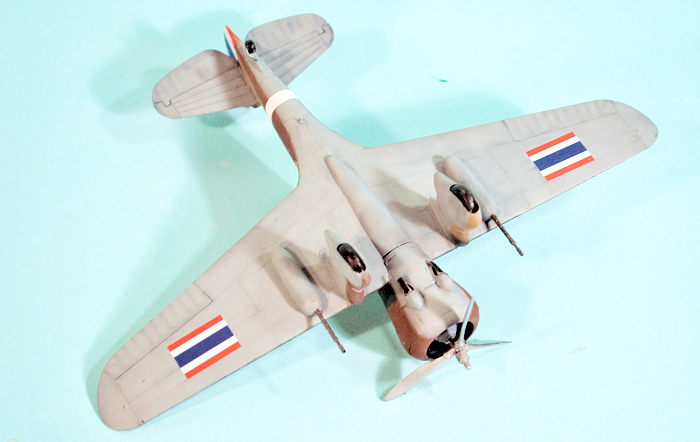 On
March 12, 1942, Seni submitted a proposal to infiltrate a group of Thai students
in the U.S. back to Thailand for subversive operations. The first group of 13
Thais began OSS training on June 12, 1942. Many were parachuted into Thailand in
1944 and 1945 for espionage work, to organize guerrilla networks, and to send
back useful intelligence. They also helped rescue downed Allied aviators.
On
March 12, 1942, Seni submitted a proposal to infiltrate a group of Thai students
in the U.S. back to Thailand for subversive operations. The first group of 13
Thais began OSS training on June 12, 1942. Many were parachuted into Thailand in
1944 and 1945 for espionage work, to organize guerrilla networks, and to send
back useful intelligence. They also helped rescue downed Allied aviators.
Although the RTAF had no role in forming the Free Thai Movement, the relationship solidified in April 1943, when Group Captain Tevarit Panleuk took over as the new RTAF commander. Secretly pro-American and a graduate of the Air Corps Tactical School, he was even more sympathetic to the movement than the former chief and allowed the resistance to use air force facilities and equipment for their underground activities. When American OSS agents began parachuting into Thailand, the RTAF offered its aircraft to transport those agents in the country, providing what amounted to a clandestine airline. The underground airline became so successful RTAF aircraft began flying agents directly into Bangkok’s Don Muang Airfield, which it shared with the Japanese.
Additionally, the RTAF provided the Allies with weather information, Japanese troop movements, and targets for American air strikes. In one case, an RTAF officer even flew with American bombers to ensure that targets were accurately identified.
One of the most dramatic rescues was that of Flying Tigers pilot William D. McGarry. On March 24, 1942, he was shot down over Chiang Mai, captured, and imprisoned at Thammasat University in Bangkok. On September 9, 1944, the university’s rector, Pridi Phanomyong, a key Seri Thai leader, welcomed a team of OSS-trained Thais who had parachuted in to rescue McGarry. Pridi informed the Japanese McGarry had died, and he was smuggled out of the prison camp in an improvised coffin and hidden in a Thai customs boat with four RTAF officers.
A Free Thai Movement member explained: “The Japanese increasingly dealt with Thailand as a conquered territory rather than as an ally. Because of their feelings of superiority and their attitudes toward the Thai, the Japanese could never believe that the friendly Thai among whom they lived could be capable of such skillful subversion.”
| THE KIT |
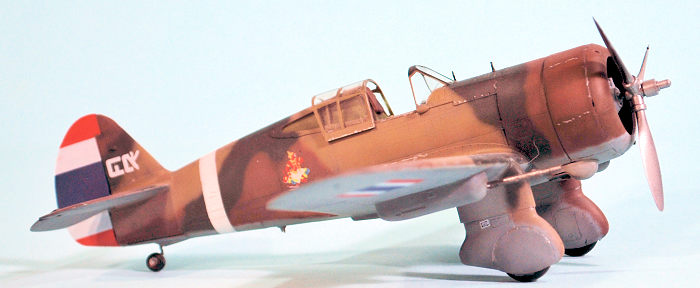 This
H-75N released by the Ukrainian company Clear Prop in August is the second kit
of the type in 1/48, with Hobbycraft having released a kit some 25 years ago.
This is the first release of a planned series of all Hawk 75/P-36 sub-types. It
is vastly superior to the Hobbycraft kit.
This
H-75N released by the Ukrainian company Clear Prop in August is the second kit
of the type in 1/48, with Hobbycraft having released a kit some 25 years ago.
This is the first release of a planned series of all Hawk 75/P-36 sub-types. It
is vastly superior to the Hobbycraft kit.
The kit is well-designed, and equivalent to Eduard’s Spitfires, Bf-109s, Fw-190s, and Tempests, with beautiful petite surface detail. Production quality is first-class.
Decals are provided for four H-75Ns at various stages of their careers with the RTAF, from an original natural-metal to one in the 1940-41 markings of the war with Vichy France, and two World War II markings. Decals are high-quality and opaque.
| CONSTRUCTION |
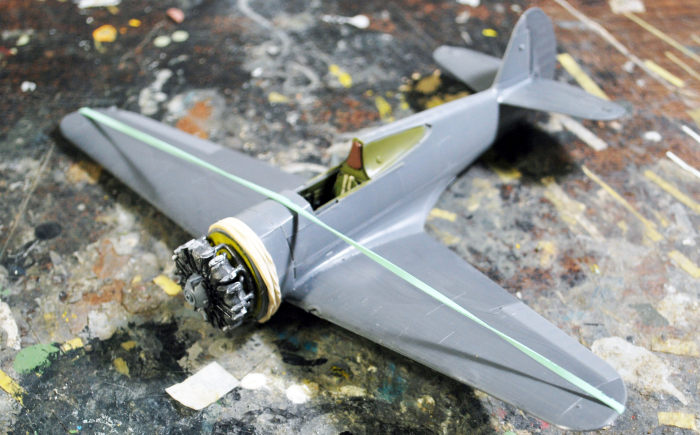 I
began by painting all the cockpit parts Interior Green, then assembled the
cockpit. I glued the fuselage halves together, then inserted the cockpit. That
was followed by attaching the parts for the forward fuselage, and then the wing
sub-assembly.
I
began by painting all the cockpit parts Interior Green, then assembled the
cockpit. I glued the fuselage halves together, then inserted the cockpit. That
was followed by attaching the parts for the forward fuselage, and then the wing
sub-assembly.
The easiest way to mount the engine and cowling is to assemble the engine, then attach the multi-part cowling (which is designed to be attached to the cylinder heads), then attach the entire sub-assembly to the fuselage, which will guarantee getting everything in the proper position. Doing it per the kit instructions can lead to misalignment (ask me how I know).
Overall assembly is easy. I differed from the instructions in drooping the elevators, and then modifying the control stick so it was in a “down” position in the cockpit. I used a resin P-36/P-40 seat from the spares box and Eduard seatbelts, rather than the kit-supplied seat and photoetch seatbelts. I also drilled out the exhaust stubs and the barrels of the 23mm cannon.
| COLORS & MARKINGS |
These airplanes arrived in Thailand unpainted, and were painted in 1940,
by which time Thailand had purchased some Japanese aircraft. I decided to use
Japanese colors for the camouflage. I used Tamiya paints: XF-72 “Brown JGSDF”
for the “light earth” color; after the fir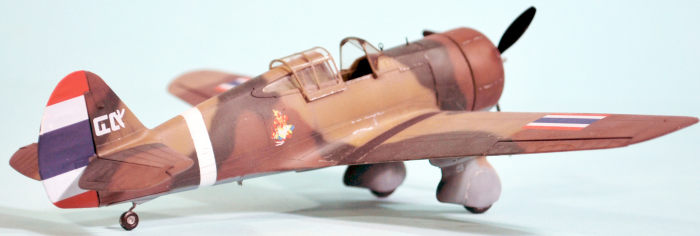 st
coat, I gave the cup a brushful of XF-3 Flat Yellow and went over in
post-shading, then added in some XF-2 Flat white and went back over the surfaces
directly in sunlight, to get sun fading. The Dark Brown was XF-79 Japanese
Linoleum Deck Brown, with some yellow again, then some light grey for fading.
The Dark Green was XF-11 “JN Green”, with some XF-26 “Deep Green” for fading.
The lower surface was painted XF-66 “Light Grey,” with some XF-2 for post
shading. All applied freehand with my Paasche-H with the fine tip, at 15psi in
the compressor. The surface detail really “pops” with paint on the model.
st
coat, I gave the cup a brushful of XF-3 Flat Yellow and went over in
post-shading, then added in some XF-2 Flat white and went back over the surfaces
directly in sunlight, to get sun fading. The Dark Brown was XF-79 Japanese
Linoleum Deck Brown, with some yellow again, then some light grey for fading.
The Dark Green was XF-11 “JN Green”, with some XF-26 “Deep Green” for fading.
The lower surface was painted XF-66 “Light Grey,” with some XF-2 for post
shading. All applied freehand with my Paasche-H with the fine tip, at 15psi in
the compressor. The surface detail really “pops” with paint on the model.
I used the decals for the markings option of the airplane involved in the “war” with Vichy France in 1940-41. The rudder decal needed trimming as it is slightly too large, but everything went down under a coat of Solvaset and melted into the surface detail without problem.
I unmasked the canopy and posed it in the open position. I attached the prop and considered all finished.
| CONCLUSIONS |
This is without a doubt the nicest and best-detailed Curtiss Hawk 75 kit released by anyone in any scale. It is a simple kit to assemble, and looks good when done. I’m looking forward to the release of the others to come.
14 October 2021
Copyright ModelingMadness.com. All rights reserved. No reproduction in part or in whole without express permission.
If you would like your product reviewed fairly and fairly quickly, please contact the editor or see other details in the Note to Contributors.